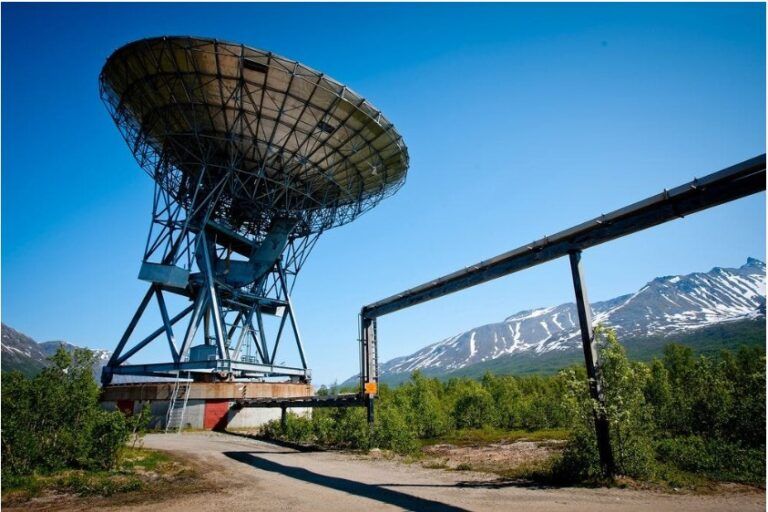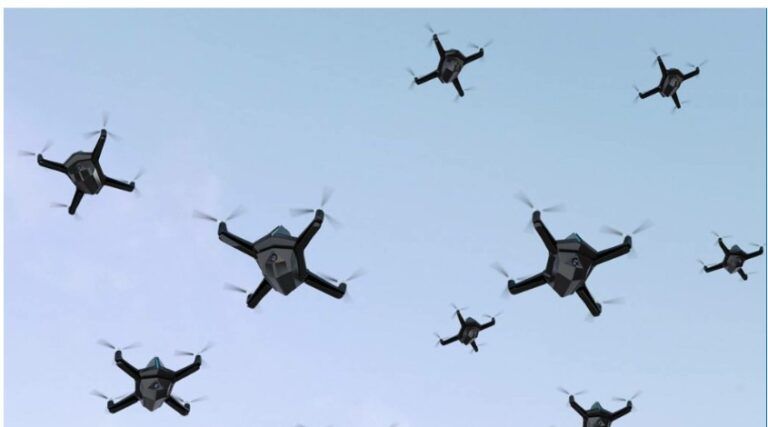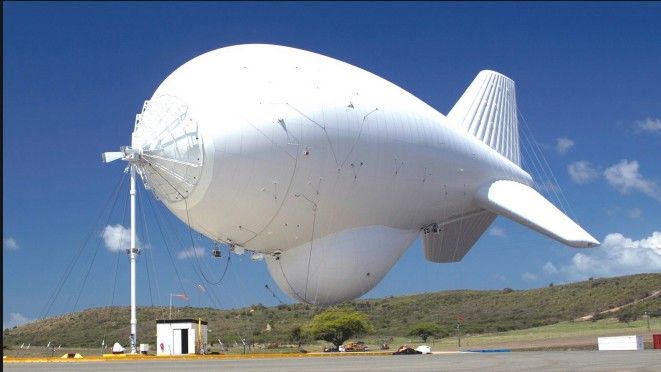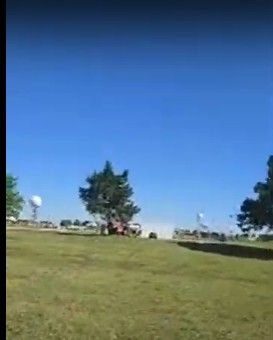EISCAT3D will be an international research infrastructure, using radar observations and the incoherent scatter technique for studies of the atmosphere and near-Earth space environment above the Fenno-Scandinavian Arctic as well as for support of the solar system and radio astronomy sciences. The radar system is designed to investigate how the Earth’s atmosphere is coupled to space but it will also be suitable for a wide range of other scientific targets for e.g space weather forecasts and detecting space debris.
EISCAT3D project leader Johan Svensson, by the EISCAT3D tests site in Tromsø *
It will be operated by EISCAT Scientific Association and hence be an integral part of an organization that has successfully operated incoherent scatter radars for more than thirty years.
Visit the EISCAT3D FAQ-section for more information.
Maps of the location are found here.
Design
Illustration of the EISCAT3D.* @NIPR
The EISCAT3D system will consist of five phased-array antenna fields located in the northernmost areas of Finland, Norway and Sweden. Each field will consist of around 10,000 crossed dipole antenna elements arranged in 109 hexagons in a honeycomb-structure. One of these sites (the core site) will transmit radio waves at 233 MHz, and all five sites will have sensitive receivers to measure the returned radio signals. The central array of each site will be of a size of about 70 m from side to side, and the sites will be located from 90 km to 250 km from the core site in order to be able to maximise the coverage by the system.
EISCAT3D is designed to use several different measurement techniques which, although they have individually been used elsewhere, have never been combined together in a single radar system. The design of EISCAT3D allows large numbers of antennas to be combined together to make either a single radar beam, or a number of simultaneous beams, via beam-forming. While traditional radar systems with a single slow-moving antenna, and thus a single beam, can only show us what is happening along a single line in the upper atmosphere, volumetric imaging allows us to see geophysical events in their full spatial context, and to distinguish between processes which vary spatially and those which vary over time.
Measurements
Illustration of the EISCAT3D in aurora.* @NIPR
EISCAT3D will measure the spectra of radio-waves that are back-scattered from free electrons, whose motions are controlled by inherent ion-acoustic and electron plasma waves in the ionosphere. The measured spectra reveal high-resolution information on the ionospheric plasma parameters, but can also be used for obtaining atmospheric data and observations of meteors and space debris orbits. In both active and passive mode, the receivers will provide high-quality scientific and monitoring data from the ionosphere as well as from space within its designed frequency spectrum. The research will both be organized through common observation modes and through requests from individual groups.
Since EISCAT3D is very flexible compared to traditional ionospheric radars, it will allow several new operating modes, including the capabilities to determine vector velocities of moving objects and to respond intelligently to changing conditions, for instance by changing the parameters of a scanning experiment. EISCAT3D will also allow remote continuous operations, limited only by power consumption and data storage. This is important for monitoring the state of the atmosphere, especially as a function of solar variability, as well as capturing events that appear suddenly and are hard to predict. Radio astronomy observations will be performed when the transmitters are inactive. Read more here.
*All pictures are examples or test-designs and may come to look different in the future.
What science will EISCAT_3D enable?
The EISCAT_3D radar system will provide a thirty-year update to EISCAT’s existing mainland facilities, exploiting the capabilities of state-of-the-art electronics, networking, storage and computing. In doing so, it will outstrip the capabilities of any such radar operating in the world and become the centrepiece of the international network of instruments monitoring the Earth’s upper atmosphere and space environment in the first half of the twenty-first century.
EISCAT_3D combines five key attributes which have never before been available together in a single radar:
Volumetric imaging and tracking
The use of advanced beam-forming technology allows the beam direction to be switched in milliseconds, rather than the minutes which it can take to re-position dish-based radars. This allows very wide spatial coverage to be obtained, by interleaving multiple beam directions to carry out quasi-simultaneous volumetric imaging. It also allows objects such as satellites and space debris to be tracked across the sky, which cannot be done by the current EISCAT radars. At the passive sites, the design allows for five simultaneous beams at full bandwidth, rising to over twenty beams if the bandwidth is limited to the ion line, allowing the whole range of the transmitted beam to be imaged from each passive site, using holographic radar techniques.
Interferometric imaging
EISCAT_3D has a modular configuration, which allows an active array to be split into smaller elements to be used for aperture synthesis imaging. The result will be an entirely new data product, consisting of range-dependent images of small sub-beamwidth scale structures, with sizes down to 20 m. All of the EISCAT_3D data will be tested continuously for the presence of such structures, so that when they appear the data can be diverted to specialised processing to determine their shape and location.
Multistatic configuration
EISCAT_3D will be the first phased array incoherent scatter radar to use a multistatic configuration. The EISCAT_3D Design Study envisaged five radar sites, consisting of two pairs located around 120km and 250km from the active site respectively, on baselines running East and South from the active core. This provides an optimal geometry for calculation of vector velocities in the middle and upper atmosphere.
Greatly improved sensitivity
The gain of the EISCAT_3D antennas and the large size of the active site arrays will deliver an enormous increase in the figure-of-merit relative to any of EISCAT’s existing radars. An active site of 5,000 elements would already exceed the performance of the current EISCAT VHF system, while an active site comprising 16,000 elements, as suggested in the EISCAT_3D Design Study, will exceed the sensitivity of the present VHF radar by an order of magnitude.
Transmitter flexibility
Each transmitter unit will have its own signal generator, allowing the generation and transmission of arbitrary waveforms, limited only by the available transmission bandwidth and spectrum mask as allocated by the respective frequency management authorities. This unique innovation allows the implementation of all currently used and envisaged modulation schemes and antenna codings (such as polyphase alternating codes, array tapering, orbital angular momentum beams) and also provides the possibility to adopt any kind of future code. In addition, it will allow advanced clutter mitigation strategies such as adaptive null steering and null shaping.
EISCAT_3D is designed for year-round continuous operation, with the passive sites operating unattended. Automated systems will be used to control and monitor the radar operations and undertake the data handling, exploiting the new capabilities in high-speed networking, high performance computing and large volume data storage now available in the Nordic region. Intelligent scheduling algorithms will allow multiple experimental modes to be run in parallel, with experiments being interchanged automatically to exploit better the changing geophysical conditions, while the data handling system is designed to preserve the lowest level data for as long as practical, retaining all available information so that it can be re-processed in the optimum way to extract the most scientific value from each observation. No radar presently operating has such advanced capabilities for flexible and autonomous operation.
Because phased array radars are inherently modular, the system can, in principle, be scaled to whatever size is needed to deliver the scientific goals, either by increasing the size (and hence the sensitivity) of each site, or adding more sites to increase the spatial coverage of the system. Our ultimate aspiration is to implement a system with multiple active sites, capable of volumetrically imaging the whole region of ionosphere above Northern Scandinavia, and even extending into other neighbouring territories. This would obviously involve a much larger facility than the one aimed for here and hence its implementation will require additional technical work to ensure that the EISCAT_3D design remains sufficiently flexible for the system to be extended.










+ There are no comments
Add yours